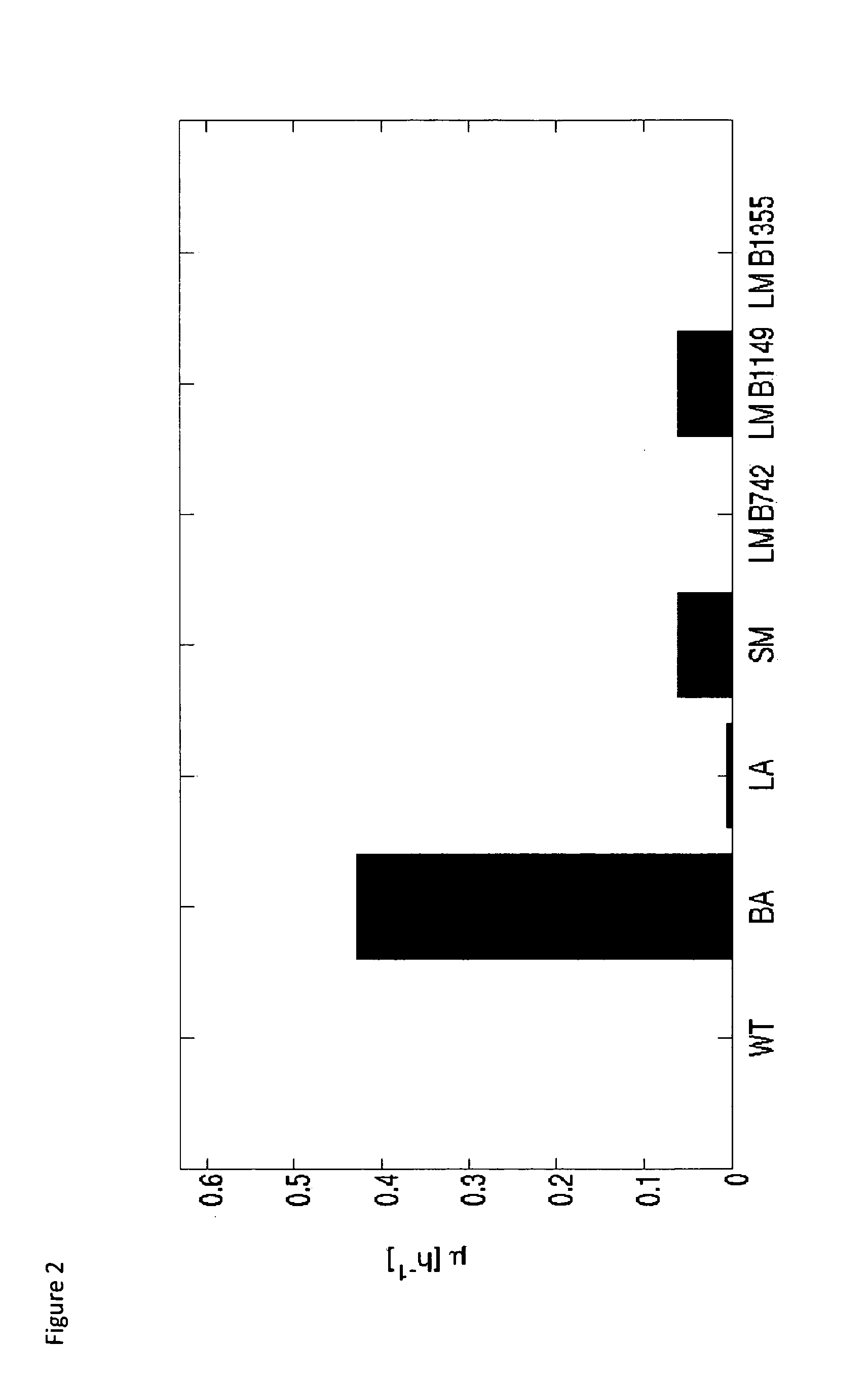Metabolically engineered organisms for the production of added value bio-products
- Summary
- Abstract
- Description
- Claims
- Application Information
AI Technical Summary
Benefits of technology
Problems solved by technology
Method used
Image
Examples
example 1
Materials and methods
Media
[0100]The Luria Broth (LB) medium consisted of 1% tryptone peptone (Difco, Erembodegem, Belgium), 0.5% yeast extract (Difco) and 0.5% sodium chloride (VWR, Leuven, Belgium). The medium for the shake flasks experiments contained 2.00 g / l NH4Cl, 5.00 g / l (NH4)2SO4, 2.993 g / l KH2PO4, 7.315 g / l K2HPO4, 8.372 g / l MOPS, 0.5 g / l NaCl, 0.5 g / l MgSO4.7H2O, 14.26 g / l sucrose or another carbon source when specified in the examples, 1 ml / l vitamin solution, 100 μl / l molybdate solution, and 1 ml / l selenium solution. The medium was set to a pH of 7 with 1M KOH.
[0101]Vitamin solution consisted of 3.6 g / l FeCl2.4H2O, 5 g / l CaCl2.2H2O, 1.3 g / l MnCl2.2H2O, 0.38 g / l CuCl2.2H2O, 0.5 g / l CoCl2.6H2O, 0.94 g / l ZnCl2, 0.0311 g / l H3BO4, 0.4 g / l Na2EDTA.2H2O and 1.01 g / l thiamine.HCl. The molybdate solution contained 0.967 g / l Na2MoO4.2H2O. The selenium solution contained 42 g / l SeO2.
[0102]The minimal medium for fermentations contained 6.75 g / l NH4Cl, 1.25 g / l (NH4)2SO4, 1.15 g / l KH...
example 2
Engineering and Usage of Base Strain 1 (Carbon Source: Sucrose; Converted into Glucose-1-Phoshate and Fructose by Sucrose Phosphorylase)—Screening of Different Sucrose Phosphorylases
[0129]An important requirement for the success of ‘base strain 1’ is the existence of a potent sucrose phosphorylase. However, though E. coli has a putative sucrose phosphorylase (SP), it does not grow on a minimal medium with sucrose as sole carbon source. Therefore, 6 sucrose phosphorylases from a variety of microbial sources were screened (Table 2)
[0130]To this end, 6 transformants of the wild type E. coli were constructed each carrying a plasmid [pCX-promoter-SP] encoding for one of the sucrose phosphorylase (SP) listed in Table 2. The performance of these strains was evaluated in shake flasks, using sucrose as sole carbon source. The wild type strain (WT) was incorporated in the experimental design as a control (μWT=0).
TABLE 2Screened sucrose phosphorylasesSource sucrose phosphorylaseAbbreviationBif...
example 3
Characterization of the Sucrose Phosphorylase of Bifidobacterium adolescentis
[0133]Various artificial constitutive promoters have been inserted to evaluate the influence of the promoter strength on the growth rate. To this end, a weak, medium strength, and strong promoter from a promoter library available at The Centre of Expertise—Industrial Biotechnology and Biocatalysis (Ghent University) were introduced. The medium strength promoter, which yielded the highest growth rate, was finally retained.
[0134]The affinity constant and the maximal growth rate of the E. coli strain carrying a plasmid encoding for the sucrose phosphorylase of Bifidobacterium adolescentis were determined. To this end, batch and chemostat experiments were run. The influence of the phosphate concentration on these parameters was checked as well (Table 3).
[0135]The kinetic properties of the engineered strain are listed in Table 3. It is clear that the kinetic properties of the engineered strain are adequate in v...
PUM
| Property | Measurement | Unit |
|---|---|---|
| Fraction | aaaaa | aaaaa |
| Density | aaaaa | aaaaa |
| Density | aaaaa | aaaaa |
Abstract
Description
Claims
Application Information
 Login to View More
Login to View More - R&D
- Intellectual Property
- Life Sciences
- Materials
- Tech Scout
- Unparalleled Data Quality
- Higher Quality Content
- 60% Fewer Hallucinations
Browse by: Latest US Patents, China's latest patents, Technical Efficacy Thesaurus, Application Domain, Technology Topic, Popular Technical Reports.
© 2025 PatSnap. All rights reserved.Legal|Privacy policy|Modern Slavery Act Transparency Statement|Sitemap|About US| Contact US: help@patsnap.com



